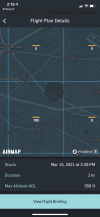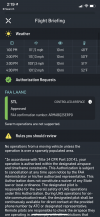- Joined
- Jun 3, 2016
- Messages
- 104
- Reaction score
- 106
- Age
- 54
This comes up a LOT and we need to do a PSA to all FAA UAS operators. On the UAS Facility Maps (LAANC Grids) there are boxes with a # in it (0 - 400). Some people mistakenly think this is the "allowed altitude by default" for that grid section. This is NOT the case. The altitude listed is the MAX altitude you will most likely get approval if you submit a request via LAANC. This is a mere shortcut so that you don't ask for 300' in a 100' location (it will get denied).
Any and EVERY flight inside of Controlled Airspace must be pre-authorized before the UAS takes off. This would be done via LAANC if it's available and your request is "normal". If it's outside of the listed altitude you'll have to submit a manual request via the FAA Drone Zone portal.
It's also important to know that not EVERY submission gets approval even if less than the noted altitude. An active airport is a very DYNAMIC area and things like Emergencies, Military Operations, VIP Activity, Maintenance, and Equipment Failures can alter normal traffic etc and a seemingly simple and routine request CAN get denied.
Any and EVERY flight inside of Controlled Airspace must be pre-authorized before the UAS takes off. This would be done via LAANC if it's available and your request is "normal". If it's outside of the listed altitude you'll have to submit a manual request via the FAA Drone Zone portal.
It's also important to know that not EVERY submission gets approval even if less than the noted altitude. An active airport is a very DYNAMIC area and things like Emergencies, Military Operations, VIP Activity, Maintenance, and Equipment Failures can alter normal traffic etc and a seemingly simple and routine request CAN get denied.






